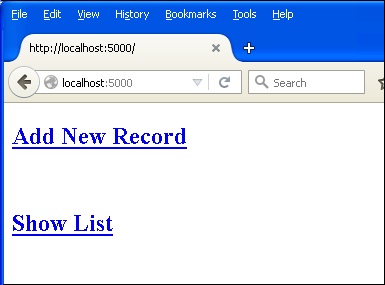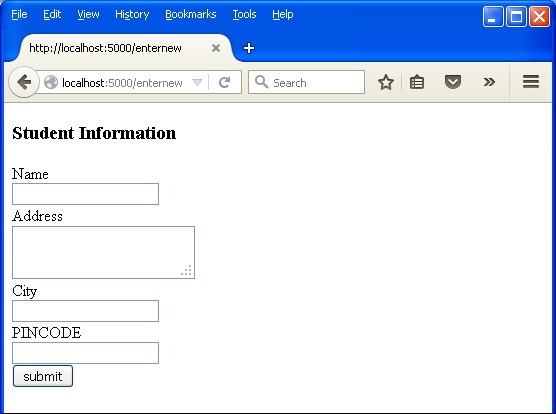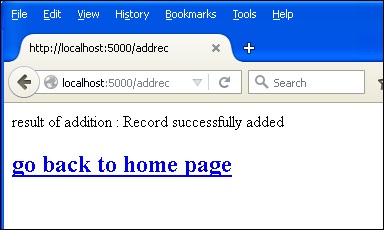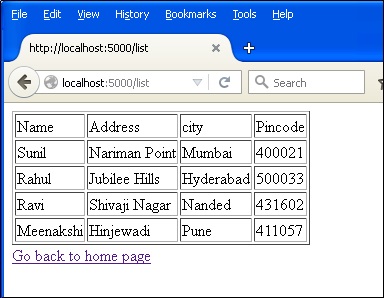Python has an in-built support for SQlite. SQlite3 module is
shipped with Python distribution. For a detailed tutorial on using
SQLite database in Python, please refer to this link. In this section we shall see how a Flask application interacts with SQLite.
Create an SQLite database ‘database.db’ and create a students’ table in it.
First new_student() function is bound to the URL rule (‘/addnew’). It renders an HTML file containing student information form.
This addrec() function retrieves the form’s data by POST method and inserts in students table. Message corresponding to success or error in insert operation is rendered to ‘result.html’.
 Click ‘Add New Record’ link to open the Student Information Form.
Click ‘Add New Record’ link to open the Student Information Form.
 Fill the form fields and submit it. The underlying function inserts the record in the students table.
Fill the form fields and submit it. The underlying function inserts the record in the students table.
 Go back to the home page and click ‘Show List’ link. The table showing the sample data will be displayed.
Go back to the home page and click ‘Show List’ link. The table showing the sample data will be displayed.

Create an SQLite database ‘database.db’ and create a students’ table in it.
import sqlite3 conn = sqlite3.connect('database.db') print "Opened database successfully"; conn.execute('CREATE TABLE students (name TEXT, addr TEXT, city TEXT, pin TEXT)') print "Table created successfully"; conn.close()Our Flask application has three View functions.
First new_student() function is bound to the URL rule (‘/addnew’). It renders an HTML file containing student information form.
@app.route('/enternew') def new_student(): return render_template('student.html')The HTML script for ‘student.html’ is as follows −
<html> <body> <form action = "{{ url_for('addrec') }}" method = "POST"> <h3>Student Information</h3> Name<br> <input type = "text" name = "nm" /></br> Address<br> <textarea name = "add" ></textarea><br> City<br> <input type = "text" name = "city" /><br> PINCODE<br> <input type = "text" name = "pin" /><br> <input type = "submit" value = "submit" /><br> </form> </body> </html>As it can be seen, form data is posted to the ‘/addrec’ URL which binds the addrec() function.
This addrec() function retrieves the form’s data by POST method and inserts in students table. Message corresponding to success or error in insert operation is rendered to ‘result.html’.
@app.route('/addrec',methods = ['POST', 'GET']) def addrec(): if request.method == 'POST': try: nm = request.form['nm'] addr = request.form['add'] city = request.form['city'] pin = request.form['pin'] with sql.connect("database.db") as con: cur = con.cursor() cur.execute("INSERT INTO students (name,addr,city,pin) VALUES (?,?,?,?)",(nm,addr,city,pin) ) con.commit() msg = "Record successfully added" except: con.rollback() msg = "error in insert operation" finally: return render_template("result.html",msg = msg) con.close()The HTML script of result.html contains an escaping statement {{msg}} that displays the result of Insert operation.
<!doctype html> <html> <body> result of addition : {{ msg }} <h2><a href = "\">go back to home page</a></h2> </body> </html>The application contains another list() function represented by ‘/list’ URL. It populates ‘rows’ as a MultiDict object containing all records in the students table. This object is passed to the list.html template.
@app.route('/list') def list(): con = sql.connect("database.db") con.row_factory = sql.Row cur = con.cursor() cur.execute("select * from students") rows = cur.fetchall(); return render_template("list.html",rows = rows)This list.html is a template, which iterates over the row set and renders the data in an HTML table.
<!doctype html> <html> <body> <table border = 1> <thead> <td>Name</td> <td>Address>/td< <td>city</td> <td>Pincode</td> </thead> {% for row in rows %} <tr> <td>{{row["name"]}}</td> <td>{{row["addr"]}}</td> <td> {{ row["city"]}}</td> <td>{{row['pin']}}</td> </tr> {% endfor %} </table> <a href = "/">Go back to home page</a> </body> </html>Finally, the ‘/’ URL rule renders a ‘home.html’ which acts as the entry point of the application.
@app.route('/') def home(): return render_template('home.html')Here is the complete code of Flask-SQLite application.
from flask import Flask, render_template, request import sqlite3 as sql app = Flask(__name__) @app.route('/') def home(): return render_template('home.html') @app.route('/enternew') def new_student(): return render_template('student.html') @app.route('/addrec',methods = ['POST', 'GET']) def addrec(): if request.method == 'POST': try: nm = request.form['nm'] addr = request.form['add'] city = request.form['city'] pin = request.form['pin'] with sql.connect("database.db") as con: cur = con.cursor() cur.execute("INSERT INTO students (name,addr,city,pin) VALUES (?,?,?,?)",(nm,addr,city,pin) ) con.commit() msg = "Record successfully added" except: con.rollback() msg = "error in insert operation" finally: return render_template("result.html",msg = msg) con.close() @app.route('/list') def list(): con = sql.connect("database.db") con.row_factory = sql.Row cur = con.cursor() cur.execute("select * from students") rows = cur.fetchall(); return render_template("list.html",rows = rows) if __name__ == '__main__': app.run(debug = True)Run this script from Python shell and as the development server starts running. Visit http://localhost:5000/ in browser which displays a simple menu like this −
 Click ‘Add New Record’ link to open the Student Information Form.
Click ‘Add New Record’ link to open the Student Information Form. Fill the form fields and submit it. The underlying function inserts the record in the students table.
Fill the form fields and submit it. The underlying function inserts the record in the students table. Go back to the home page and click ‘Show List’ link. The table showing the sample data will be displayed.
Go back to the home page and click ‘Show List’ link. The table showing the sample data will be displayed.

No comments:
Post a Comment